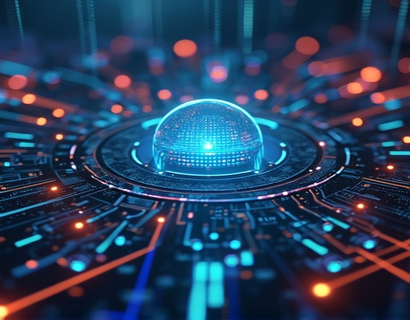Crypto-Driven Digital Transformation: Harnessing AI for Enhanced User Experiences in the Ucosystem
The digital landscape is undergoing a profound transformation, driven by the convergence of cryptocurrency and artificial intelligence (AI). This synergy is not only redefining how we interact with digital services but also unlocking new potentials for innovation, growth, and connectivity. As we delve into this evolving tech ecosystem, it's crucial to understand how these technologies are intertwining to create seamless and enhanced user experiences.
The Intersection of Cryptocurrency and AI
Cryptocurrency, since its inception, has been more than just a digital currency. It represents a decentralized and secure way of conducting transactions, powered by blockchain technology. AI, on the other hand, is revolutionizing the way we process and analyze data, making systems smarter and more efficient. When these two technologies converge, the possibilities are vast and transformative.
The integration of AI in cryptocurrency systems enhances security, efficiency, and user experience. For instance, AI algorithms can analyze vast amounts of data to detect patterns and anomalies, thereby improving fraud detection and transaction security. This is crucial in a space where security is paramount. Moreover, AI can optimize blockchain performance by managing network congestion, reducing transaction times, and lowering fees.
Enhancing User Experiences through AI
One of the most significant impacts of AI in the digital ecosystem is the enhancement of user experiences. AI-driven personalization is a key factor here. By analyzing user behavior and preferences, AI can tailor digital services to individual needs, making interactions more intuitive and satisfying. This level of personalization is particularly powerful in complex systems like cryptocurrency platforms, where users may need assistance navigating various functions and understanding market dynamics.
Chatbots and virtual assistants powered by AI are becoming increasingly common in this space. These tools provide 24/7 customer support, answer queries, and guide users through complex processes. For example, an AI-powered chatbot can help a user set up a wallet, explain the differences between various cryptocurrencies, or even provide real-time market insights. This not only improves user satisfaction but also reduces the burden on human support teams, making services more efficient.
Fostering Innovation and Growth
The combination of cryptocurrency and AI is a fertile ground for innovation. Startups and established companies alike are leveraging these technologies to develop new applications and services. For instance, AI-driven trading bots can analyze market data and make informed trading decisions, potentially increasing returns for users. These bots can adapt to changing market conditions, providing a competitive edge in the fast-paced world of cryptocurrency trading.
Moreover, AI can facilitate the development of decentralized applications (dApps) that are more user-friendly and accessible. Traditional blockchain applications often suffer from usability issues, but AI can streamline these processes. For example, AI can automate the creation and management of smart contracts, reducing the complexity and risk associated with their use. This makes blockchain technology more approachable for a broader audience, fostering greater adoption and innovation.
Connectivity and Interoperability
Another critical aspect of the crypto-AI synergy is the enhancement of connectivity and interoperability within the digital ecosystem. AI can help bridge the gap between different blockchain platforms, enabling seamless interaction and data exchange. This interoperability is essential for building a cohesive and integrated digital environment where users can seamlessly move between various services and applications.
Cross-chain solutions, powered by AI, can facilitate this by intelligently routing transactions and data across different blockchains. This not only improves efficiency but also enhances the overall user experience by providing a more unified and fluid digital environment. Users can benefit from a more connected ecosystem where services work together harmoniously, regardless of the underlying technology.
Security and Trust
Security remains a top priority in the crypto-AI landscape. The integration of AI in security protocols can significantly enhance the protection of user data and assets. Machine learning algorithms can continuously monitor network activity, identifying and mitigating threats in real-time. This proactive approach to security is crucial in a space where the stakes are high and the potential for cyber attacks is ever-present.
Moreover, AI can help build trust in decentralized systems by providing transparency and accountability. Blockchain's inherent transparency, combined with AI's ability to verify and validate transactions, creates a robust framework for trust. Users can have greater confidence in the systems they interact with, knowing that their data and transactions are secure and verifiable.
Challenges and Considerations
While the potential of crypto-AI integration is immense, there are challenges that need to be addressed. One of the primary concerns is the regulatory landscape. As these technologies evolve, regulatory bodies are still grappling with how to oversee and govern them. Ensuring compliance while fostering innovation is a delicate balance that requires collaboration between stakeholders.
Another challenge is the technical complexity involved in integrating AI with blockchain systems. Developers need to possess a deep understanding of both technologies to create effective and efficient solutions. Education and training programs can play a vital role in bridging this gap, equipping professionals with the necessary skills to drive this transformation forward.
Future Prospects
Looking ahead, the future of the digital ecosystem with crypto-AI integration is bright. As technology continues to advance, we can expect even more sophisticated applications and services. The convergence of these technologies will likely lead to the development of new paradigms in areas such as finance, healthcare, and beyond.
For instance, AI-driven predictive analytics combined with cryptocurrency can revolutionize financial planning and investment strategies. In healthcare, blockchain and AI can enhance data management and patient care, leading to more personalized and efficient medical services. The possibilities are endless, and the role of these technologies in shaping the future is undeniable.
In conclusion, the integration of cryptocurrency and AI is a powerful force driving digital transformation. By enhancing security, personalization, connectivity, and innovation, these technologies are reshaping the way we interact with digital services. As we continue to explore and harness their potential, the digital ecosystem will become more robust, user-friendly, and transformative, paving the way for a more connected and intelligent future.



